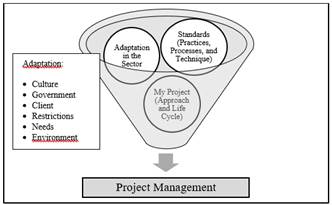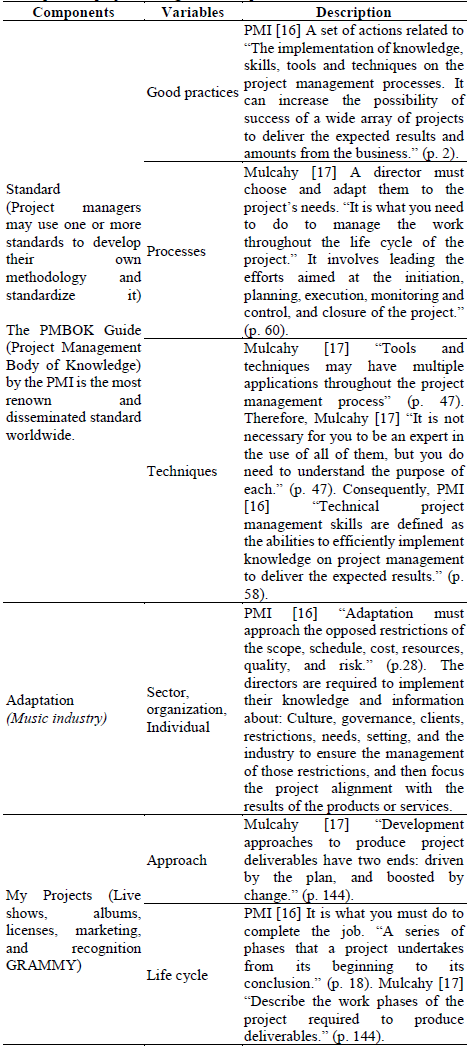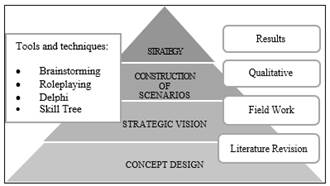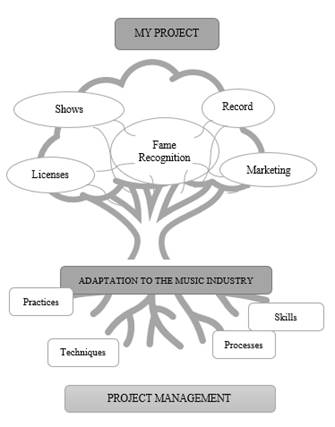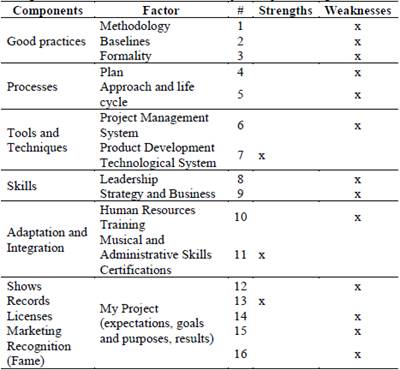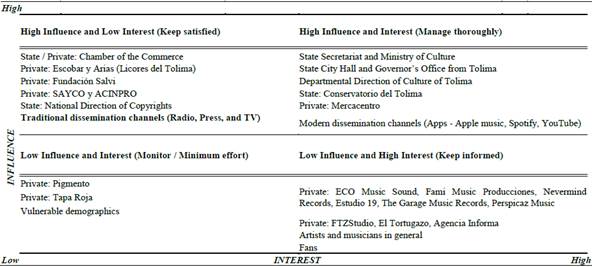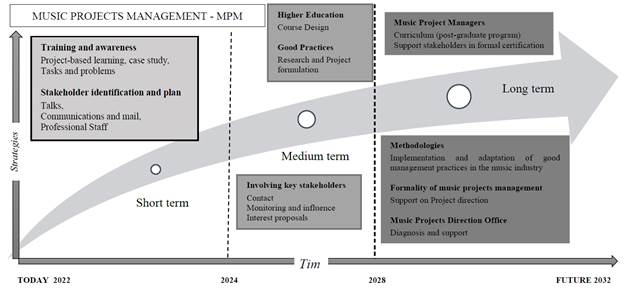1. Introduction
Music plays an essential role in the economy and culture of any country. It has been proved that, involving management as a means to success, good results are achieved on this field and any other where good management practices are implemented. Therefore, the directors and organizations that follow project management standards and methodologies improve their performance in the direction of such projects, fulfilling the needs of the interested parties, and with the strategic goals of the Project Management Institute (PMI) [1].
Consequently, several economy sectors are implementing good practices of project management, such as construction, health, environmental sustainability, or software development, among others. However, the music sector lacks of explicit information that validates the aforementioned. This means, project management specialized journals such as the International Journal of Project Management (Science Direct), the International Journal in Managing Project in Business (Emerald), and the Project Management Journal (PMI), do not evince articles related to project management in music industry, which is a knowledge gap in that specific knowledge topic, and an opportunity to involve stakeholders in the issue. Likewise, [2] Buitrago shows that there are few records of scientific research on project management in music projects and confirms that artists lack of documentation that approaches them to project management knowledge and leads them on the necessity of conducting research on their own.
Some studies from the Culture Management academic program from Universidad EAN have made an approach related to the music industry, like the case of Gómez and Ibarra [2] on their Strategic Direction graduation thesis for the music group Greta Amada, where they concluded that artists fail to structure and develop their projects, and do it without goals and a direction, which lead them to failure, and breaches of artistic talent.
On the other hand, another recent study to be published on Ediciones EAN, by Roa, Uribe, and Rueda, titled “Analysis of Complexity Factors in Project Planning of the Music Sector under PMI Standards, and developed with musicians graduated from the Conservatorio del Tolima, showed that they are not aware of good practices of Project Management, and that they are largely discontent with the results of their projects when contrasted with their expectations, but they still want to learn and develop those skills.
On that matter, Feist [4] claims that one of the challenges that musicians face is to integrate formal project management in the efforts of the art itself. Likewise, Velasco [5] and Rocha da Cruz [6] state that most music projects are developed empirically and informally, with a noticeable lack of management.
Therefore, the purpose of this paper is to make a prospective analysis of the music sector under the artistic context in the management of music projects in Ibagué.
Theoretical foundations
2.1. Prospective analysis
The conceptual development of this topic is analytically divided into four main components under the prospective context for the development of the proposal: Prospective, Key or Strategic Variables, Stakeholders, Construction of Scenarios, and Strategy.
2.1.1 Prospective
For the Real Academia Española [7], the prospective is a set of analysis and studies aiming to explore or predict the future, a time to come. Within this concept, Perilla and Gonzalez [8] claim that, additionally, there are several tools and techniques, and of the mostly known and used methods is the one of future stages, which helps to reduce uncertainty at the moment of decision-making.
2.1.2. Key or strategic variables
From the perspective approach, Godet and Durance [9] talk about the importance of identifying those internal and external variables that find links to tendencies or knowledge by stakeholders until reaching a strategic vision. On that same context, Ruiz [10] infers on the selection of those variables that contain change factors, that are relevant and mark their importance.
2.1.3. Stakeholders
Within the prospective context, stakeholders can be related as groups of people, called social actors, segmented into four families: State, Means of production of goods and services, Academy, and Civil society. Each one of them in the defense of their interest and the degree of influence that each of them has. Consequently, “It is not enough that the futures we identify may occur, but it is also necessary that, at least one of the social actors involved is capable of making it happen.” Mojica [11].
2.1.4. Construction of scenarios
Therefore, Mojica [11] defines that a scenario is an image of the future composed of a path to make it, where several types are identified: Probable Scenario, also known as Tendentious or Referential, based on probability laws, and Alternate Scenarios, also known as Bet Scenarios, which try to find the most convenient one among different options in case of taking the wrong one.
2.1.5. Strategy
Mojica [11] defines strategy as “The purpose, goals, and actions by which we can construct the scenario on which we bet” (p. 131) Consequently, Godet and Durance [9] integrate strategic planning by scenarios, whose goal is “to propose the strategic leading and actions based on the skills of the organization according to the evolution scenarios of its environment” (p. 29).
2.2. Music industry
Under the artistic context, Katz [12] defines that music can be understood as “an organized set of sound ideas, expressed in different possible manifestations or representations” (p. 429). Likewise, the music industry is “the one that takes music from the first link of the production or creation chain - the author/composer, to the final consumer” (p. 429). Therefore, it is important to highlight that this industry is divided into two groups: First: service industry, composed of live concerts and music broadcast on radio, television, press, digital media, and others. Second: production of goods or products. Composed of the publishing of licenses - melodies, lyrics, and scores - and discographies in different physical or digital formats.
On the other hand, Wikström [13] claims that “To understand the dynamics of music industry, it is necessary to know that there is not only one, but several and closely related to one another, but starting from different logics and structures” (p. 10). Thus, these structures are divided into three pillars: First: Discography, which consists on music recording and its distribution to consumers. Second: Music licenses, related to copyrights for the operation of compositions and arrangements. Third: Live music, the area responsible for the production and promotion of live shows and events, such as concerts, tours, and festivals.
On Tables 1 and 2, each component of the music industry and the actors involved are described.
Table 1 Description of music industry components.
| Components | Description |
|---|---|
| Live concerts | The main funding source for producers, businesspeople, and artists. Money is collected thanks to concerts, and show production and promotion. Additionally, it is one of the first steps to release an artist in the music world. |
| Music dissemination | Record labels that manage markets promote, disseminate and commercialize artists’ products in consumption sectors through digital media such as iTunes, Spotify, Deezer, YouTube, and other music Apps, without leaving aside conventional media, like radio stations, aiming to reach the highest possible amount of audience. |
| License publishing | The music editor promotes the works in the market and tries to give them space on record and advertisement projects in exchange for a waive of use rights. This reflects on millionaire profits for the industry, but not for the artists, which oftentimes are cast aside as content suppliers through the sale of their creations (scores, melodies, and others). |
| Record company | One of the commercialization and dissemination of music products, works on royalties and percentages of the profits obtained from the creations of the artists. However, artists nowadays have more facilities and access to technology to record their creations in an amateur fashion, using specialized, yet user-friendly software. |
Source: Developed by author, taking Pardo [14] as reference.
Table 2 Actors involved from the music industry
| Actors | Agent | Description |
|---|---|---|
| Artist | Artistic | In the music context, all those creative agents, composers of music pieces among soloists, bands, ensembles, and interpreters. |
| Manager | Executive | Aims to lead the artist to continuous progress, a guide and counselor focused on projecting the artist’s career to succeed. They have knowledge in aspects such as consulting in the artistic, music, advertising, and public relations areas. They also define the most effective means to use the whole potential of the artist. |
| Music editor | Executive | Commercializes music pieces from authors and composers. They earn royalties for such work. In Colombia, there are: ACODEM - Asociación Colombiana de Editoras de Música (Colombian Association of Music Edition Labels); SAYCO - Sociedad de Autores y Compositores de Colombia (Society of Authors and Composers of Colombia); and ACINPRO - Asociación Colombiana de Intérprete y Productores Fonográficos (Colombian Association of Phonographic Interpreters and Producers). |
| Music producer | Executive and artist | Responsible for recording the music. This means, interpretation and execution. They must know well the market to ensure the music sale. They release pieces that, to their criteria, may become music hits into the market. |
| Arranger | Artist | Ensembles the instruments and sound effects of a piece within the production process in the artistic area, and designs the scores for instrument players and singers. |
| Mixer | Executive and artist | Organizes the recording and mixing of voices, instruments, and harmonic rhythm background, with synchrony and orderly fashion according to the different sound levels and importance of each sound. They can also add sound effects to the piece. |
| Advertising agency | Executive | The designer in the process of developing the cover and back cover of a CD, and the artist's image. They work with photographers, models, image consultants, and others. |
| Marketing director | Executive | They are responsible for making a promotion and advertising plan to reach media (radio, press, and television). Lately, music videos have also been included, and also through press releases, posters, interviews, and other resources. |
| Secretariat of Culture | Executive | Consisting of pro-culture organs that support the music sector in the city and the country. Consequently, they contribute and promotion of the music sector and the Ministry of Culture at national level with the incentives program. |
| Freelancer | Executive or artist | An agent that moves within the music sector where sponsors, journalists, radio stations, festivals, and other related actors participate. |
Source: Developed by author, taking Giraldo [15] as reference.
2.3. Project management
From the Real Academia Española [7], management, direction, administration and leading, are interrelated terms with similar concepts that can be used as synonyms. Consequently, within the context of projects, those terms consolidate within the English term “Project Management,” which PMI [16] defines as “The implementation of knowledge, skills, tools and techniques on the project activities to comply with its requirements.” (p. 10). Therefore, Fig. 1 presents an approximate scheme on the integration process to manage or develop a methodology in a project.
There is a brief description of the three fundamental components in project management on Table 3: Standards, Adaptation, and My Project.
2.3.1 Music project management
As mentioned in the introduction, there is little information about relevant sources of indexed articles and books. Therefore, an exhaustive search of information from different sources such as theses, conferences, books, and articles that contribute to the study object was carried out.
According to the music teacher and researcher Velasco [5], the artist has not completely assumed formality in music project management. “It is necessary for the XXI century musician to have management skills for their own talent.” (p. 128). Similarly, Szarruk [18] agrees that times have changed, and a musician must be a manager of their own career instead of following an old music industry model (musician - label - distributors - audience) that may lead to failure.
On the other hand, Fox [19] refers to the five largest record labels (BMG Entertainment, Sony, AOL Time Warner, EMI, and Vivendi Universal Music Group) as the old models that controlled the monopoly of music industry, traditional media (Discs, cassettes, radio, TV). However, technology has forced in some new business models with the purpose of successfully meeting the needs of consumers in the environment of electronic commerce.
In this regard, Jian and Zhang [20] see music as a highly flexible, generative, and fast-changing technology that shifts with time that has important consequences for human culture and biology.
According to the Manual para portafolios de proyectos musicales (Handbook for music projects portfolio) from the Ministry of Culture [21], it is necessary for artists to develop a business model with a defined strategic plan, to make the music project feasible and sustainable.
A summary on the functionality of a strategic plan adapted to music project management is described on Table 4.
Table 4 Description of the music project management strategic plan
| Project Presentation | Project purposes |
|---|---|
| This section must be short and concise, and it must have the essential items that make the band or group outstanding over the competition. | Example: Rank the band as the most important Latin urban sound music group in the Andean region market. |
| Project Goals | Executive Summary |
| Example: Goals can be achieving a nomination in national music awards, getting rotation of the music video of their single on the most important music channel of the region, playing at a massive festival organized by the district. | The executive summary must focus on the reason why the project is attractive and a differential factor for an investor or strategic partner, |
| Timeline of work | Strategic Analysis |
| Example: The project must be divided in subprojects that aim to reach the purposes and goals set in previous points for a group in the creation process. Subprojects may include music composition and creation, recording the album, staging the live show, designing an image coherent with the music style, and developing a digital strategy, among others. | The main purpose of developing a SWOT is to find opportunities for the music project to reach new listeners, to create a fan base and grow the branding of the group. |
| Funding and budget plan | Work team |
| Budget, an investment needed to execute the subprojects proposed. Occurrence: Music projects usually die in the process due to the lack of financial planning that allows guaranteeing a return on the investment. | The manager is the person who manages the rest of the work team, composed of a promotion chief, an image and digital designer, the technical staff such as the sound engineer and a stage manager, and a musical producer, among others. |
Source: Developed by author, taking Ministry of Culture as reference [21].
3. Methodological framework
Along the development of this paper, there are two types of research: exploratory and descriptive. First, a literature revision was carried out by collecting bibliographic information, aiming to define an approximation of variables that lead to identify tendencies, change factors, and surrounding features.
On the second phase, a field work was carried out, aiming to set the project management in the music sector. A survey was used to directly ask the experts that represent a great influence in the music industry in Ibagué, self-taught musicians, Conservatory musicians, music teachers, managers, music producers, managers from the Secretariat of Culture, among others. With this information, a statistical, exploratory, and descriptive analysis was deployed.
Finally, on a third phase, different prospective tools and techniques described on Fig. 2, were implemented to obtain and document results that helped to establish the connection of approximate and strategic variables with the construction of future scenarios and the effective or strategic way to approach the bet scenario for a formal management of music projects.
The research methodology used on this study is shown on the following Fig. 2.
A non-probabilistic sample was selected for the demographics of this study. A filter was applied by thoroughly selecting a smaller group with more experience in music industry project development. The database ended up with a tally of 12 experts. After that, a letter of invitation to the event was sent, which reduced the real demographics to 8 participants. See Table 5 in Results.
4. Results
According to the conceptual design and the information analysis of the theoretical background, an approximation of the possible variables of the music sectors and project management was identified, which were considered as strategic variables for the development of field work with the experts.
Strategic variables are shown in the skill tree (Marc Giget’s Technique) of Fig. 3.
4.1. Strategic vision
According to the literature revision and the field work, an examination of the current situation and potential conditions of project management in the music industry of Ibagué was carried out. Therefore, a physical meeting, and then, several interviews with the experts in the music industry and some social actors took place, using forms.office.com for data abstraction, and recording a video as a memoir of the meeting and the attendance.
The number of experts that participated in the field work is shown in Table 5, as follows:
Below, on Table 6, are shown the strengths and weaknesses of music industry in project management, obtained from the experts using the Delphi method with interviews and surveys.
Table 5 Group of experts in the music industry.
| Workshop with experts | Meeting | Interviews |
|---|---|---|
| Self-learning musician | 1 | 0 |
| Conservatory Musicians | 1 | 1 |
| Conservatory Teachers | 1 | 0 |
| Managers | 1 | 0 |
| Music Producers | 1 | 1 |
| Culture Management | 1 | 0 |
Source: Developed by author.
4.2. Scenarios
Aiming to assess the different alternative scenarios of music industry in project management, the purposes to take into account were selected and prioritized.
The selected purposes, hierarchically organized from higher to lower priority, obtained in consensus with the experts, are shown on Table 7.
Table 7 Prioritization of purposes to take into account in the music industry in project management.
| Priority Orders | Purposes | In order to |
|---|---|---|
| 1 | To create a music projects management office | Assess management and implement continuous improvement strategies. |
| 2 | To design music project management plans | Clarify all project details before starting and to monitor and control progress and performance and accomplish business goals. |
| 3 | To obtain formal and non-formal education in project management. | Obtain a common language through accredited certifications in project management. Include project management subjects in college and superior music education. Train staff in formal and non-formal education institutions on project management. |
| 4 | To create high-performance work teams. | Increase productivity and compete with more efficiency in their markets. |
| 5 | To generate value and improve economy in music industry. | Support and improve performance of the sector wherever it operates. |
| 6 | To strengthen formality in music projects management. | Increase visibility of projects and encourage articulation of projects with public or private entities. |
| 7 | To standardize a music projects management methodology. | Enhance success opportunities and improve efficiency and accuracy of projects. |
| 8 | To increase satisfaction of all shareholders. | Obtain recognition, improve image and position in the market. Increase reputation and influence network. |
Source: Developed by author.
Table 8 Different scenarios in future construction of music industry in music projects management.
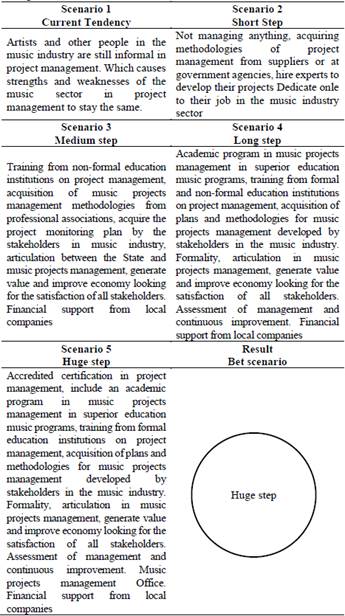
Source: Developed by author
Based on the above, different alternate scenarios were constructed, and one of them was selected as the bet scenario (desired) by the experts.
The different scenarios (probable, alternate, and bet) are shown on Table 8, as follows:
4.3. Strategies
From the bet scenario, a roleplay of social actors was carried out, identifying and qualifying them for their influence and interest in the construction of that future and, likewise, the way to make it achievable was determined.
An influence and interest matrix of the social actors, qualified by the experts, is shown in Table 9.
A graphic of the strategies in a timeline is shown as the way to achieve the future bet scenario, carried out by brainstorming and approval of the experts, is shown on Fig. 4.
Considering the results, it is necessary to develop the strategies proposed through project management, along with relevant social actors to construct the bet scenario within the next ten years (2032).
Finally, with the experts, a probability between 80 to 99% of achieving the proposed strategies and complying with the construction of the future bet scenario within the next ten years (2032) was estimated.
On the other hand, with the results in this research, and aiming to deepen further in this study of good project management practices in the music industry, the experts characterized this issue as a topic of interest for all members (participants or actors) of the music sector and other stakeholders in general.
5. Conclusions
This study determined, using a prospective analysis, the strategic variables, the different scenarios (probable, alternate, and bet), the influence and the interest of social actors, along with the strategies for the construction of the future scenario, bet of the music sector in Ibagué in music projects management.
One of the most important phases to fulfill the general purpose of this research was the conceptual design and the skill tree to identify strategic variables, as they allow having a view from the past and the present in order to have accuracy in tendencies, change factors, and features of the environment, through the strengths and weaknesses of the music sector in project management.
Thanks to the participation of the experts, it was possible to make the prospective workshops (Delphi method, roleplaying, and brainstorming), and reach an agreement among them to obtain data aiming to reliable results, which provide, in turn, the bet scenario and its strategies.
About the priority of the purposes of project management in the music industry, experts highlighted as a number one “To create a Music Project Management Office,” which is the highest point in the maturity of an organization in the management world in any economy sector, and for that, it is necessary to include experts with knowledge, skills, and experience in project management.
The importance of project management as a means to reach success in music projects was socialized and determined in the meeting. Experts considered that it is of great interest for everyone to include it in their lives to manage their talents, projects, or personal duties. On the other hand, they are confident between an 80 and a 99% that the bet scenario can be constructed within the next ten years (2032).
Therefore, regarding the music sector in project management, it is possible to state that music projects are developed empirically or intuitively, which leads to informality. It is essential that social actors generate change and follow the strategies proposed on this research, which will allow standardizing, formalizing, and improving the performance of music projects management.
As a recommendation regarding the evidence collected, a projects program (related projects) can be developed to facilitate synchronization and coordination of the implementation of all strategies proposed in different projects, allowing resource optimization, and knowledge transfer to obtain the benefits of each project.














